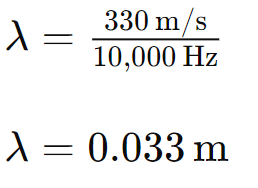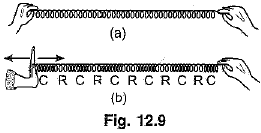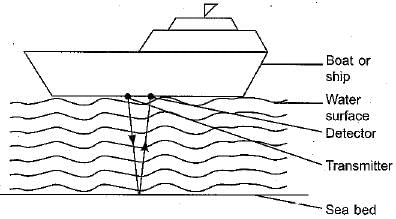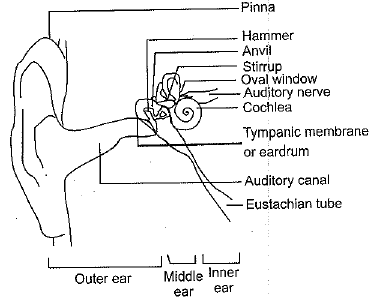Class 9 Science - Sound Previous Year Questions
Short Answer Type Questions
Q.1. The successive crest and trough of a wave 30 cm apart. Find the wavelength. Also, find the frequency of the wave if 10 crests and 10 troughs are produced in 2s.
Ans: Wavelength = Distance between successive crests = 2 x 30 cm = 60 cm = 0,6 m
Waves produced in 2 s = 10.
Waves produced in 1s  = 5 Hz = frequency
= 5 Hz = frequency
Q.2. The velocity of sound in air is 330 m/s. Find the wavelength of sound waves if its frequency is 10 kilohertz.
Ans: Wavelength λ =v/f
Where:
- v is the velocity of sound in air (330 m/s)
- f is the frequency of the sound waves (10 kHz = 10,000 Hz)
Substituting the given values into the formula:

So, the wavelength of the sound waves is 0.033 meters.
Q.3. What is an echo?
Ans: Repetition of a sound due to reflection from an object like a large building or a cliff etc. is called echo.
Q.4. Why are the walls and roof of an auditorium covered with sound-absorbent materials?
Ans: To reduce reverberation of sound in the auditorium.
Q.5. Establish a relation between wavelength, frequency and speed of sound in a medium.
Ans: The speed of sound is defined as the distance which a point on a wave travels in a unit time.
As distance covered by wave in one time period is called the wavelength, hence
But  = number of vibrations completed per unit time = v = frequency
= number of vibrations completed per unit time = v = frequency
or Speed of sound (v) = frequency (v) x wavelength (λ)
Q.6. (a) Flash and thunder are produced simult generously. However, thunder of a cloud is heard a bit late than the flash of lightning is seen. Explain why.
(b) Sound produced by thunderstorm is heard 10 s after the lightning is seen.
Calculate the approximate distance of the thunder cloud. (Given: Speed of sound in air - 340 m/s)
Ans: (a) In lightning process, flash and thunder are produced simultaneously. Flash is seen almost immediately because speed of light is extraordinarily large (c = 3 x 108 m s-1). But thunder is heard a few seconds later because speed of sound is much less (about 346 m s-1 at 25°C) and requires time to cover up the distance from the site of thunder in sky to us.
(b) Given that speed of sound in air v = 340 m/s and time of thunder t = 10 s
∴ Distance of the thunder cloud s = vt - 340 x 10 = 3400 m or 3.4 km
Q.7. If the frequency of a tuning fork is 400 Hz and the speed of sound in air is 350 ms-1, find how far sound travels while the tuning fork makes 16 vibrations.
Ans: Here frequency v = 400 Hz and number of vibrations completed by the tuning fork n = 16.
∴ Time taken to complete these vibrations 
As the speed of sound in air v = 350 m s-1 .
∴ Distance covered by sound in a given time 
Q.8. 20 vibrations are produced in a slinky in 10 seconds when a jerk is given to it. Find its period and frequency. How can a longitudinal wave be produced in that slinky?
Ans: As the time taken for 20 vibrations is 10 s, hence period T = 
∴ frequency v = 

Hold one end of a slinky tightly in your right hand and the other end in your left hand so that the slinky remains straight between your two hands. Keeping your right hand fixed, move your left hand alternately pushing and pulling the slinky. It is observed that a longitudinal wave has been set up in the slinky. At some places, successive turns of the slinky come closer. These indicate regions of compressions (C). At some other places, the successive turns of Slinky move away from one another and the spacing between the turns increases. These indicate the regions of rarefactions (R). Thus, as shown in the Figure alternate compressions and rarefactions are formed in the slinky and a longitudinal wave propagates from one end of the slinky to the other end.
Q.9. A girl is sitting in the middle of a park of dimensions 12 m x 12 m. On the left side, there is a building adjoining the park and on the right side of the park, there is a road adjoining the park. A sound is produced on the road by a cracker. Is it possible for the girl to hear the echo of this sound? Give a reason to justify your answer. Given that speed of sound in air is 344 ms-1.
Ans: Distance travelled by sound and its echo
= Length of park length of park (echo)
length of park (echo)
= 12 m + 6 m - 18 m
Speed of sound = 344 m/s; Time taken
Similarly, time taken by original sound
Time lag between echo and original sound
= 0.03 s
Since 0.03 s < 0.1 s, the girl cannot detect the echo (∵ our ears can detect an echo only when it reaches after a time gap of at least 0.1 s).
Q.10. Waves of higher frequencies are used to measure depth of the sea.
(a) Name these waves.
(b) Give the frequency of these waves.
(c) Give one more use of these waves.
Ans: (a) Ultrasonic waves.
(b) Waves of frequency greater than 20 kHz.
(c) These waves are used in medical science for echocardiography and ultrasonography. These are also used to detect flaws in metal blocks and ultrasonic cleaning.
Q.11. (a) Explain how a bat is able to fly freely even in dark.
(b) A bat can hear the sound into frequency 120 kHz. Determine the wavelength of the sound wave. Given speed of sound in air is 344 m/s.
Ans: (a) A bat is able to fly freely even in dark by emitting and detecting reflections c high frequency ultrasonic waves.
(b) Here frequency v = 120 k Hz - 120 x 103 Hz and speed of sound v = 344 m/s
∴ Wavelength v = 
Q.12. For what does the acronym SONAR, stand?
Ans: Sound Navigation And Ranging.
Q.13. Identify the part producing sound in the following musical instruments :
(a) Table
(b) Mouth organ
(c) Veena
Name the type of waves produced in each case.
Ans: (a) The membrane and the enclosed air produces sound in a Tabla and longitudinal waves are produced.
(b) The air column inside a mouth organ vibrates and produces longitudinal waves to produce a sound.
(c) The taut strings in Veena execute transverse vibrations and produce sound.
Q.14. Define three characteristics of a musical sound. On which factor do they depend?
Ans: Three characteristics of a musical sound are :
(i) Loudness, which enables us to distinguish between a loud sound and a soft sound. Loudness depends on the amplitude of sound and response of ear to the sound. Higher the amplitude of sound, louder the sound is.
(ii) Pitch, which enables us to distinguish between a shrill sound and a hoarse sound. Pitch of a sound depends on the frequency of sound and increases on increasing its frequency.
(iii) Quality or Timbre, which enables us to distinguish between sounds produced by two different persons or musical instruments although both may have same pitch and same loudness.
Q.15. Name the types of waves and two examples associated with:
(a) Compressions and rarefactions.
(b) Crests and troughs.
Ans: (a) Longitudinal waves: Sound waves, ripples in water.
(b) Transverse waves: Light waves infrared waves.
Q.16. Can sound travel through vacuum?
Ans: No, sound cannot travel through vacuum.
Q.17. What is SONAR? Explain with the help of labelled diagram how does it work?
Ans: SONAR (Sound Navigation and Ranging) works on the principle of reflection of sound. Sound waves are sent into the water by SONAR device. These strike the underwater objects such as rocks, icebergs and even submarines and get reflected back. The reflected waves are detected by detector and time taken by them to return back is measured. This helps to measure depth of objects in the sea.
Q.18. A radar signal is reflected fay .an aeroplane and is received;2 x 10-5 s after it was sent. If the speed of these waves he 3 x 108 m s-1, how far is the aeroplane from radar?
Ans: Here wave speed v = 3 x 108ms-1 and time of reception of reflected signal t = 2 x 10-5 s.
∴ Distance of aeroplane from the radar 
Q.19. (a) What type of waves are produced before actual earthquake?
(b) Name two species of animals which can detect and produce these waves.
(c) What is the range of hearing for children under the age of five?
Ans: (a) Infrasonic waves are produced before actual earthquake.
(b) Rhinoceroses, elephants and whales can produce and detect infrasonic waves.
(c) For children under the age of five years, the range of hearing extends from 20 Hz to 25 kHz.
Long Answer Type Questions
Q.1. (a) Give three medical uses of ultrasound.
(b) A ship which is stationary is at a distance of 2800 m from the sea bed. This ship sends an ultrasound signal to the seabed and its echo is heard after 4 s. Find the speed of sound in water.
Ans: (a) Important uses of ultrasound in medical held are as follows:
(i) In an ultrasound scanner, the ultrasonic waves are used for getting images of internal organs of the body such as liver, gall bladder, kidney, uterus, etc. The technique is known as ultrasonography
(ii) Echocardiography is a medical diagnostic technique in which ultrasonic waves are used to construct the image of heart.
(iii) Powerful ultrasounds are used for treatment of kidney stones.
(b) Distance of ship from seabed d - 2800 m, time of echo t = 4 s. If speed of sound in water be v, then
Q.2. Draw labelled diagram of auditory parts of human ear explain how the human ear works.
Or
Draw a diagram of structure of human ear. Label any four auditory parts on it and write their functions.
Ans: A neat labelled diagram of a human ear has been shown in the following figure. For working of ear. The outer ear called ‘pinna’ collects the sound from the surroundings. The collected sound passes through the auditory canal, at the end of which there is a thin membrane called the eardrum. When a compression of the medium reaches eardrum, the pressure on the outer side of membrane of eardrum increases and forces the eardrum inward. Similarly, at the time of rarefaction, the eardrum moves outward. Thus, eardrum begins to vibrate. Three bones of middle ear (the hammer, anvil and stirrup) amplify these vibrations. The middle ear transmits the amplified pressure variations to the inner ear. The inner ear converts the pressure variations into electrical signals. Auditory nerve then sends these electrical signals to the brain. Brain interprets them as sound.
Q.3. (i) The units of certain parameters of a mechanical waves are given:
Name the corresponding parameter of a mechanical wave and define each:
(a) metre
(b) metre per second
(c) hertz
(d) second
(ii) Two sounds A and B are of different pitch B appears to be heavier as compared to A. What can be said about their comparative frequencies.
Ans: (i) (a) Wavelength: It is the distance between two consecutive compressions or rarefactions in the wave.
(b) Velocity/speed: Distance travelled by wave per unit time is called wave speed.
(c) Frequency: The number of complete wave cycles occurring per unit time is called frequency of wave.
(d) Time period: The time taken by one complete wave cycle is its time period.
(ii) Since B has a heavier sound, the pitch is lower than that of A. Thus, its frequency is less than that at A.
Q.4. Two waves are shown below:
(i)
(ii) 
(a) Which of the two waves corresponds to high pitched sound?
(b) Name the characteristics of sound the graphs represent.
(c) Define the characteristic.
(d) Explain the reason why sound of school bell is heard over long distance while that of a blow by hand on a wooden desk remains limited to room.
Ans: (a) None corresponds to high pitched sound as frequency is less.
(b) The graphs represent amplitude, wavelength, time period and frequency of sound.
(c) Wavelength - The distance between two points in consecutive waves having the same phase is called wavelength.
Frequency - The number of complete oscillations in one second is called frequency.
Time period - Timetakenforonecomplete oscillation to occur is called time period.
Amplitude - Maximum displacement of an oscillating particle from the mean position is called amplitude.
Q.5. What is an echo? State two conditions for an echo to be heard. Bats cannot see, then how do they catch their prey? Explain.
Ans: Reflected sound is called echo.
(i) Reflecting surface should be at a distance such that echo reaches our ears after a time lag of at least 0.1 seconds.
(ii) Reflecting surface should not absorb the sound and must reflect sound properly.
Bats send ultrasonic squeaks which are reflected back when they strike prey. The bats detect this reflected wave and catch their prey.
Q.6. (a) Write full form of SONAR. Explain how it can be used to determine the depth of the sea.
(b) Briefly explain two other applications of ultrasound.
Ans: (a) SONAR means Sound Navigation and Ranging. For its working and use, SONAR system consists of a transmitter and a detector and is installed on a ship or motorboat. The transmitter produces and transmits ultrasonic waves. These waves travel through water and strike the object beneath on the sea bed. The object reflects these waves and the reflected waves are sensed by the detector. The detector converts the ultrasonic waves into electrical signals. If d be the depth of the said object and v the velocity of ultrasonic waves in water, then time interval between transmission and reception of ultrasonic waves will be
By knowing the time t we can find the value of d.
SONAR technique is used to determine the depth of the sea and to locate underwater hills, valleys, submarine, iceberg, sunken ship etc.
(b) For two other applications of ultrasound, For frequency, see point number 15 under the heading “Chapter At A Glance”.
For wavelength, see point number 16 under the heading “Chapter At A Glance”.
Echo is the phenomenon due to which a person listens repeated sound on account of reflection of the sound from some distantly situated reflector.
Ultrasonic sound is used for different purposes. Some important applications are :
(i) Ultrasonography technique is used by doctors to get images of internal organs of the human body.
(ii) Ultrasounds can be used to detect cracks and flaws in metal blocks.
(iii) Ultrasound is used to clean parts located in hard to reach places.
SONAR is a device that uses ultrasound waves to measure the distance, direction and speed of underwater objects.
|
84 videos|384 docs|61 tests
|
FAQs on Class 9 Science - Sound Previous Year Questions
| 1. শব্দ কী? |  |
| 2. শব্দ কেমনভাবে প্রপাগেট হয়? |  |
| 3. ধ্বনি ও শব্দের মধ্যে পার্থক্য কি? |  |
| 4. শব্দ প্রপাগেশনের সময় কেন্দ্রীয় বৈশিষ্ট্য কী? |  |
| 5. শব্দের পরিমাণিক মাত্রা কি? |  |






















